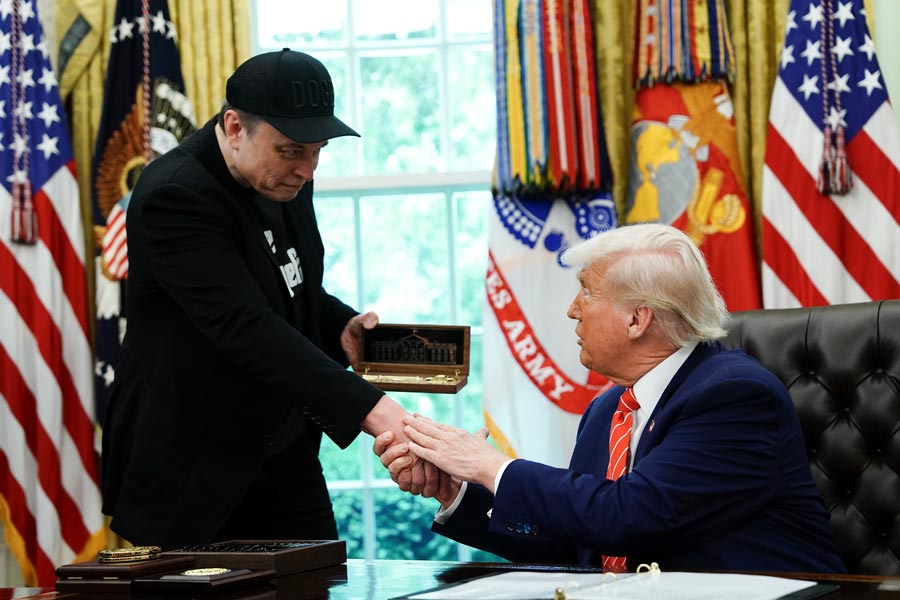 |
| The concept of the 100 drums festival was mooted as an effort to prevent erosion of culture. Picture by Eastern Projections |
Bidhayak Das considers the changing face of the Wangala festival, caught between tradition and Western influence
Tradition has always played a vital role in the lives of the tribals of Meghalaya. More so for those who live in the Garo Hills. But down the line, a lot of changes have taken place and today traditional concepts and tribal cultures are virtually fighting a battle for survival. Take the Wangala festival of the Garos. This age-old festival, also called the 100 drums festival, does not attract the fanfare that it used to some two decades back and has become a tradition of the past. Well-known intellectual of Garo Hills Prof. Milton Sangma describes it as “a dying tradition”. H.A. Marak, the author of the brochure titled 100 Drums Wangala is of the opinion that “due to the impact of foreign cultures and religions, the traditional customs and practices of the Garos are disappearing and are not without the risk of vanishing from society”.
The people of Garo Hills are at the crossroads, divided between culture, religion and a fast-blowing Western influence that threatens to erode society, as some believe. Of course there are others who hold religion responsible for the erosion of tradition. Those who believe that conversion has played a role in changing the mindset of the people and drawing them away from traditional festivals like the Wangala say that religion may not be “directly responsible” for the waning of tradition. According to them religion other than the traditional one has resulted in a natural transfer of interest from one culture to another. But at the same time it has kept the spirit of tradition, especially the Wangala, buried deep inside.
Normally, tradition to a tribal is like a honeycomb to a bee, which is perhaps why the influence of borrowed cultures notwithstanding, Garos are unwilling to let go off traditional bondages especially that associated with the Wangala. The fanfare may have vanished and the enthusiasm diminished, but no one is prepared to divorce himself or herself completely from the Wangala. There seems to be a gradual realisation that this highly colourful festival must be preserved and projected to the outside world as “one of the few unique tribal cultures” — not just for the sake of identity but to give the festival, which is truly wonderful, its rightful place.
This year’s celebration at the Asanang ground in Rongram under West Garo Hills was a clear attempt by those who have taken upon themselves the onus of protecting tradition and culture to showcase the “beauty and richness” of the Wangala to the people. More importantly the attempt was a step forward in preserving this tradition first among the people of Garo Hills and then popularising it to the world outside. Little known to the outside world, the Wangala in the truest sense of the term is a festival that is performed by the Garos after harvesting. There seems to be no end to the argument on whether rapid conversion to Christianity should be attributed to the decay of tradition of the tribals of Garo Hills. Some schools of thought even suggest that tradition should be separated from religion so that both can coexist without any conflict. The reasoning sounds logical to many in the Garo Hills who feel that in order to stop the conflict and arrest the habit of finding flaws with either religion or tradition, there should be no bar on practising age-old traditions. The fact that many Christian Garos participated in the festival at Asanang on November 8 this year showcased that it is not just another exercise packed with ceremonies and rituals but a conscious effort to display sentiments and values that the Garos attach to this festival.
In this year’s Wangala at the Asanang the turnout was just about satisfactory, but what was encouraging to see was the younger crowd, who participated in the festival cutting across all religious and cultural barriers. Dressed in their colourful best with the traditional dak mandas, lungis and accessories like headgear with cock-feather plumes and specially-woven waist jackets, young students from villages and towns of the Garo Hills thronged the Asanang ground to hear the 100 drums beating at one go and also to cheer their troupes to victory in the drum-beating and dance competitions. Thanks to the Hundred Drums Wangala Festivals Organisation, a registered organisation, people from all sections of society participated in the festival. More importantly, media from all over the world was there to capture the Wangala on film.
In spite of the restrictions imposed by the excise department on free sale and consumption of the local brew called bitchi (made of rice), people still found enough to drink, and if lucky, a little more to get tipsy. The merrymaking has been curtailed but that has not dampened the people’s desire to celebrate Wangala as it used to be celebrated, with a lot of bitchi and dance to the sounds of the drums and bugles, flutes, gongs and cymbals. Normally the celebrations go on for almost a month till the grand finale when petite women and brawny men dressed in their traditional best perform to a packed audience in the courtyard of the nokma (tribal chief) who performs the various ceremonies associated with the Wangala.
The Garos are extremely sentimental about their culture and feel strongly about the Wangala which is meant to evoke the goodwill and blessings of the gods and goddesses of heaven and earth, one of them being Misi Saljong or the Sun God. Garos believe that Misi Saljong had instructed mankind not to eat the new crop without first offering some to Minima Kiri Rokkime, the mother goddess of all crops. It is believed that the goddess comes to earth once every year to shower her blessings on mankind. The Garo tribals, who practice jhum cultivation have been performing religious ceremonies every season so as to invoke Okamdoa Rimdosala or the Great Mother Goddess to come to the jhum field and bless the crops. This belief, which is closely associated with socio-cultural and economic lifestyle of the people of Garo Hills, made them perform the Wangala festival. Till today, the festival begins with the Rugula ceremony where rice beer, vegetables from the paddy field and cooked rice are offered to Goddess Minima ki Rokkime and Misi Saljong.
The 100 drums concept was born much later and grew under the patronage of the government of Meghalaya. The idea to bring acceptable changes in the Wangala and celebrate it along modern lines was first mooted by a group of “modern intellectuals”, basically to stop Western influences from disturbing this age-old traditional fiesta of the Garos. Thenceforth, a group of 300 dancers with 100 drums would perform at the Wangala and added to it was the element of competition among various contingents. This year, there were a total of 10 contingents from different parts of Garo Hills, all-competing for top honours. For the record the first Hundred Drums Wangala Festival was celebrated on December 6-7 in 1976 at Asanang under the Rongram block headquarters in West Garo Hills.
Meghalaya’s first chief minister late Capt. Williamson A. Sangma who attended the first celebration had said “the Wangala festival of the Garos will never die”.
Sangma was right. The Wangala has withstood the trials and turbulence, but what has been lacking is the interest shown by society at large to make the Wangala not just any other ordinary festival, but a carnival and an attraction for tourists from all over the world. The festival has not received proper attention from the media and from culture centres around the world. Those who have come from far-off places, some from as far as Sweden and France, have been fascinated by the richness of the Wangala and the wide range of beliefs and practices that are associated with it. What perhaps has to be realised, as Milton Sangma says, is the need to understand culture and its importance in society. There is definitely an underlying current, which is strongly blowing across Garo society with a message to do some soul-searching to save a rare and beautiful festival like Wangala from dying.











